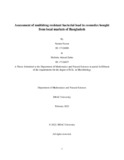Assessment of multidrug resistant bacterial load in cosmetics bought from local markets of Bangladesh
Abstract
A total of 27 brands of commercially available lipsticks, powders and creams were collected from different parts of Dhaka, in order to test their level of contamination. Organisms were detected from 85.2% of the cosmetic products. The aerobic plate counts ranged from 6- 4.4×10 15,40- 6.7×1012 and 0-3.4×1013 in case of lipsticks, powders and creams respectively. The limit given by the FDA was exceeded by 77.78% of the samples. From the samples both Gram-negative (Escherichia coli, Pseudomonas aeruginosa, Klebsiella pneumoniae, Salmonella spp. and Shigella spp.) and Gram-positive organisms (species of Streptococcus, Staphylococcus, Bacillus Lactobacillus and Listeria monocytogens were identified. Hemolysis was observed in 50% of Gram-positive bacteria and 14% of Gram-negative bacteria. The identified bacteria were tested for multidrug resistance. All of the Gram-positive and Gram-negative samples showed multidrug resistance. However, the percentage of multidrug resistance varied from sample to sample and depended on the type of bacteria. The Gram-positive bacteria of lipstick samples showed 77-100% multidrug resistance. In case of powder and cream samples of Gram-positive bacteria the multidrug resistance observed was 66-100% and 71-100% respectively. In Gram-negative bacteria, lipsticks powders and creams multidrug resistance observed was 28-100%, 0-68%and 0-60% respectively. High levels of microbial contamination occur during manufacturing of cosmetic products and the presence of pathogenic organisms poses a likely hazard to public health. Manufactures should ensure microbiological quality control testing and hygienic environments in order to lower the level of bacterial contamination.

